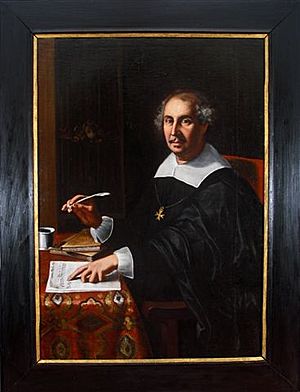Tarquinio Merula facts for kids
Quick facts for kids
Tarquinio Merula
|
|
|---|---|
 |
|
| Background information | |
| Born | 24 November 1595 Busseto, Italy |
| Died | 10 December 1665 (aged 70) Cremona, Italy |
| Genres | Baroque |
| Occupation(s) | Composer, organist, violinist |
| Instruments | |
| Years active | 1616–1665 |
Tarquinio Merula (born November 24, 1595 – died December 10, 1665) was an Italian composer, organist, and violinist. He lived during the early Baroque period.
Merula mostly worked in Cremona, Italy. His musical style was similar to the Venetian school. He was one of the most forward-thinking Italian composers of his time. He was especially good at using new musical ideas in sacred music, which is music for religious services.
Contents
Life of Tarquinio Merula
Merula was born in Busseto, a town in Italy. He probably learned music in Cremona, where he first worked as an organist.
In 1616, he became an organist at a church in Lodi. He stayed there until 1621. After that, he moved to Warsaw, Poland. There, he worked as an organist for King Sigismund III Vasa.
In 1626, Merula returned to Cremona. In 1627, he became the maestro di cappella (music director) at the main cathedral there. He only stayed for four years. In 1631, he moved to Bergamo for a similar job. The previous music director, Alessandro Grandi, had died from a terrible plague. Merula had a big job to do, rebuilding the music program after many musicians had died.
Merula later had some difficulties with his students. He decided to go back to Cremona and stayed there until 1635. During this time, he often had problems with the people he worked for. After disagreements with the leaders in Cremona, he went back to Bergamo. He worked at a different church this time. However, he was not allowed to use any musicians from his old job.
In 1646, he returned to Cremona for the last time. He worked as the maestro di cappella at the Laudi della Madonna until he passed away in 1665.
Music and Influence
Merula was very important in developing several musical forms. These forms became very popular later in the Baroque era. Some of these include the cantata, the aria, and different types of sonatas. He also worked with variations on a ground bass and the sinfonia.
Sacred Music Contributions
In his sacred music, Merula followed the ideas of Monteverdi. He often used Monteverdi's techniques. But he also did new things, like writing motets for a single singer with string instruments.
His music published in 1639, 1640, and 1652 includes masses. These masses use repeating bass lines called ostinato basses. Some of his music sounds like the concertato style of Giovanni Gabrieli. His music also showed a modern sense of tonality, which means it had clear musical keys.
Secular Music and Opera
Merula's secular music (non-religious music) includes solo madrigals. These were sung with instruments. Sometimes he used the stile concitato (agitated style) effect, which involves fast repeated notes. This style helped lead to the later Baroque cantata, which had separate sections for singing (aria) and speaking (recitative).
He wrote one opera called La finta savia. It was performed in 1643. An opera is a play set to music.
Instrumental Music Innovations
Among his instrumental music, there are many ensemble canzonas. These pieces have different sections, which was a step towards the later sonata da chiesa. His writing for string instruments, especially the violin, was very skilled. It showed what was possible for violin music in the future.
He also wrote canzonettas (short songs) and dialogues. He composed keyboard toccatas and capriccios. One famous piece is his Sonata cromatica. Merula was interested in almost every new musical trend in northern Italy.
Works
Tarquinio Merula wrote many different types of musical pieces. Here are some of his important collections:
- Il primo libro delle canzoni a 4 (1615): This book has 12 canzonas for four instruments. Canzonas are like instrumental songs.
- Il primo libro de madrigaletti (1624): This collection contains madrigals for three voices and a continuo (a bass instrument and a keyboard).
- Il primo libro de motetti e sonate concertati (1624): This book includes motets and sonatas for two to five voices.
- Il secondo libro delle canzoni da suonare (around 1631): This has 12 canzonas for three instruments, usually two violins and a bass instrument.
- Canzoni overo Sonate concertate per chiesa e camera (1637): This is a book of canzonas or sonatas for church and chamber (non-church) settings. It's for two or three instruments.
- Curtio precipitato et altri capricii, libro secondo (1638): This book features pieces for a solo voice.
- Concerto messi, salmi concertati (1639): This collection includes masses and psalms for two to eight voices and instruments.
- Il Quarto Libro delle canzoni da suonare (1651): This is another book of canzonas for two or three instruments.
See also
 In Spanish: Tarquinio Merula para niños
In Spanish: Tarquinio Merula para niños

